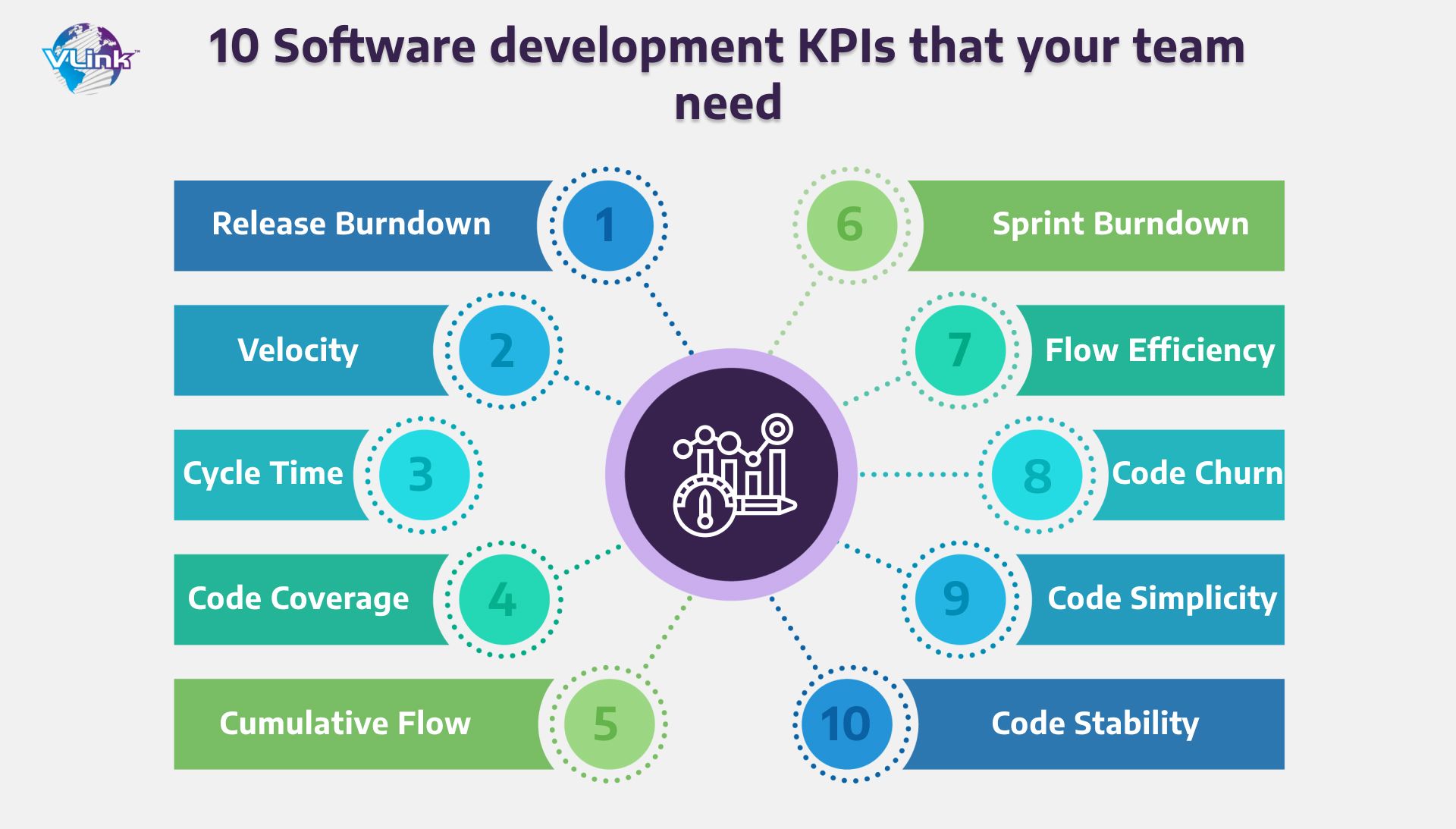Top 10 KPIs for Software Development Team
As a company owner or manager, you aim to achieve business goals and success at the end. That's where software development KPIs come into play.
 4 minute
4 minute
Software engineering KPIs allow you to measure your team's strengths and weaknesses and further work on them to improve results. Modern software development services focus on improving processes by introducing operational metrics and strengthening qualitative parameters.
Select the right KPIs to measure efficiency and performance at every stage if you want reliable and profitable software.
Table of Content:
1. What are software development KPIs (Key Performance Indicator)?
- What are the Types of Software Development KPIs?
2. Benefits of Software Development KPI Metrics
3. 10 Software Development KPIs that Your Team Need
- Velocity
- Sprint Burndown
- Release Burndown
- Cycle Time
- Cumulative Flow
- Flow Efficiency
- Code Coverage
- Code Simplicity
- Code Churn
- Code Stability
4. Conclusion
5. Select the Right KPIs for your Software Development Project with VLink!
6. FAQs–
- What are tools to track KPIs in software development?
- What are the most important metrics to measure during software development?
- Why Are Metrics in Software Development Important for Your Business?
But what are the right KPIs for your software development team?
In this blog, you will learn what software development KPIs are, their types, benefits, and the most prominent KPIs.
What are Software Development KPIs?
Short for Key Performance Indicators, KPIs indicate standard values against which your business's overall performance is measured. KPIs in an enterprise software development environment represent how well your business objectives guide the software development processes in a project.
To this end, businesses must choose the most suitable software development KPI metrics, keeping business scalability in mind.
What are the Types of Software Development KPIs?
Software development KPIs usually measure the activities and performance of a company. These metrics are broadly divided into three categories:
- Financial
- Customer
- Performance
Financial Metrics
Software developers use financial KPIs to measure the company's profits and revenue. Many businesses measure finance metrics such as working capital for development, net profit margin, monthly recurring revenue (MRR) from subscriptions and other income, ASP (Application Service Provider), etc.
Customer Metrics
Estimating your customer's satisfaction, retention, and efficiency is one of the most vital customer metrics.
For instance,
You can measure CLV (customer lifetime value) and CAC (customer acquisition cost) through this metric.
Performance Metrics
KPIs for software developers measure how the company performs activities. In addition, you can use metrics to determine the time spent on discovery, project requirements gathering, project planning, development testing, and so on.
Benefits of Software Development KPI Metrics
A software development company can help you put software metrics in place and significantly benefit your project management in different ways:
- Put processes, environments, and resources in defined categories to streamline software product development.
- Understand and predict future development in the relationships between products and processes.
- Timely detect roadblocks, inefficiencies, and potential issues to enable you to improve processes by finding solutions to these problems.
As a client, you can set reasonable KPIs for developers. You can also leverage your well-measured and -monitored management capabilities across processes and projects to define your business language.
As a result, you reduce software development project costs, improve ROI, optimize workload management, and discover improvement areas.
10 Software development KPIs that your team needs

#1 - Velocity
Speed is significant when employees want to complete tasks within the agreed timeline. Story Points can help you measure the work done for the effort invested in software creation. Story scores can give you an accurate estimate of the resources required to complete the project successfully.
For any project, three sprints are enough to understand the time your team will need to complete it. Using speed as a metric, you can adequately assess your team's capability to achieve its goals.
#2 - Sprint Burndown
Sprint burning is the way to determine KPIs for the software development team by measuring the number of tasks done during each sprint. However, a set of main coefficients determine the overall score.
To this end, sprint burning involves using special charts to summarize information. It is done by measuring time resources and understanding them compared to scores.
The insights can guide you to restructure your work processes to flow faster.
#3 - Release Burndown
Regarding the progress of a digital software release, the release burndown metric enables the team to manage the progress adequately. It helps track if the team is meeting the established time limit and is doing its job within the defined period.
Top software development outsourcing companies that develop key performance indicators leverage publication generation diagrams to understand the team's current state. It means how delayed the team is from their scheduled time, how far ahead, and if the schedule is being monitored.
#4 - Cycle Time
This KPI metric demonstrates the effectiveness of software development work. It evaluates the performance of the entire time through an objective assessment. It sees if the work is performed at the proper level and an accurate pace.
For example, the metric can help eliminate any inconsistencies and further help revise the performance duties according to the set workflow objectives.
#5 - Cumulative Flow
Program tasks and requests can be represented on a visual chart in a cumulative flow metric. It involves stages of work marked in different colors. These can be the following stages in the process of task completion: "Acknowledged," "Task in progress," "Adjustment," "Project approved," and so on.
Regardless of schemes and KPIs, they all work per the predefined scheme to ensure that the workflow suits the client and enables the team to perform step-by-step tasks.
#6 - Flow Efficiency
This metric defines the time duration in software development and the time invested. It's an important aspect of any production process, as a high per-hour rate of goods produced increases your market sales. Likewise, the more you achieve in an enterprise software development project, the faster you can launch the final product on the market.
Failure to complete a job means zero progress, prolonged waiting periods, and unmet goals. The metric can identify deviations from the established plan or process, ensuring that each task is executed properly.
#7 - Code Coverage
Code is a decisive and fundamental aspect of creating a software application, and the metric shows how efficiently the code is done. Code Coverage is indispensable to the entire lifecycle of a digital product, from creation and testing to delivery and upgrades.
This KPI helps in error detection, shows debugging needs, and covers 100% of the code, leading to writing the code qualitatively in the first go.
#8 - Code Simplicity
Another important KPI for software development is code simplicity.
For simple and clear code, this metric is ideal. But, if your code is complex, you may have to give extra time to debugging and support.
Code simplicity can be quantified in different ways.
Cyclomatic complexity is another metric of code simplicity. It measures the number of independent paths your code might take - the fewer, the better.
#9 - Code Churn
Code churn, often used as code stability, measures the frequency of code changes over time.
This metric is used during DevOps to measure how often developers rewrite or iterate the code due to new features or upgraded software versions.
An experiment by GitPrime's data science team found that the average code churn levels run between 13-30% (70-87% code efficiency).
However, DevOps can comfortably operate at 25% code churn, representing 75% code efficiency.
#10 - Code Stability
Code stability is one of the most challenging software developments KPIs. Programmers can measure the changes in code within the software. Alternatively, they can track these channels' frequency to measure the best activity.
Conclusion
Employing key performance indicators at every stage of software development helps detect errors early on and optimize all tasks for product success.
Choosing KPIs that make the most sense for your unique enterprise software development project extends an excellent foundation for confident and accurate planning and problem-solving at every development step.
If you don't know how to choose the right software development KPIs, VLink will assist you!
Select the Right KPIs for your Software Development Project with VLink!
VLink is one of the top software development companies for end-to-end custom software development solutions that meet each client's needs.
In every project, we strategically plan to achieve the set targets at every stage of development, thanks to our exemplary custom software development process.
Our developers follow the right KPI to measure the success of your software development project. When you hire us to build secure, user-friendly, and reliable software, our developers will help you select the right KPIs.
Schedule a one-on-one consultation to understand how our development expertise can help you create your next high-performance software.
FAQs
Frequently AskedQuestions
Many tools can be used to track different KPIs in software development, including project management, KPI dashboard software, information radiator, Power BI, Oracle Analytics Cloud, and CRM (Customer Relationship Management).
The most important software performance metrics are availability, reliability, serviceability, and throughput.
Software development metrics are important for your business to track progress and desired outcome, detect software challenges, align business objectives, and boost team productivity and motivation.













